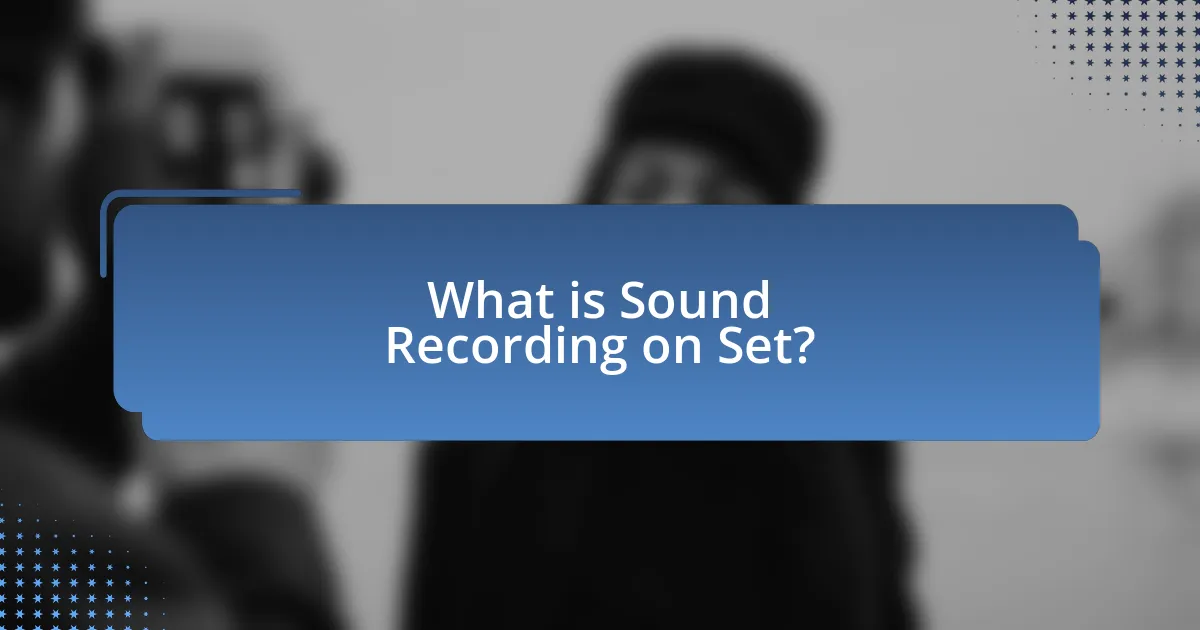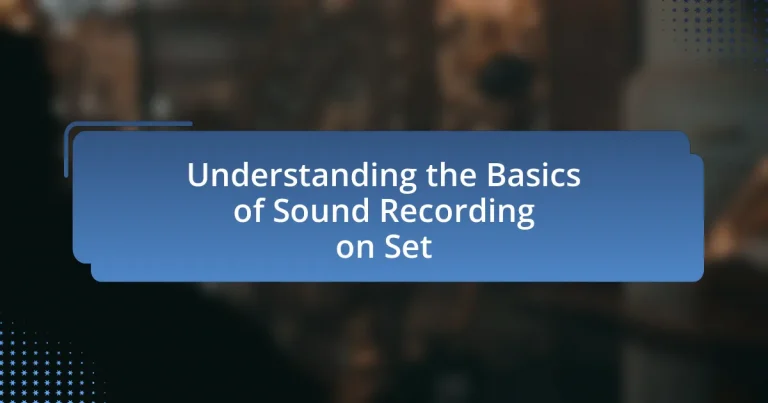Sound recording on set is the process of capturing audio during filming, utilizing microphones and recording equipment to ensure high-quality dialogue, sound effects, and ambient noise. This article explores the differences between on-set sound recording and other methods, such as ADR, emphasizing the importance of real-time audio capture for production quality. Key elements of sound recording, including microphone types, audio mixers, and the significance of location, are discussed, alongside best practices for achieving optimal sound quality. Additionally, the article addresses common challenges faced during recording and the essential post-production considerations that enhance the final audio output.

What is Sound Recording on Set?
Sound recording on set refers to the process of capturing audio during the filming of a scene in a production environment. This involves using microphones and recording equipment to ensure that dialogue, sound effects, and ambient noise are accurately recorded in real-time, allowing for high-quality audio to be integrated into the final edit. The importance of sound recording on set is underscored by the fact that it significantly impacts the overall production quality, as poor audio can detract from the viewer’s experience and may require costly re-recording or dubbing in post-production.
How does sound recording on set differ from other recording methods?
Sound recording on set differs from other recording methods primarily in its real-time capture of audio during filming, which allows for synchronization with visual elements. This method utilizes specialized equipment, such as boom microphones and lavalier mics, to capture dialogue and ambient sounds in the actual filming environment, ensuring authenticity and immediacy. In contrast, other recording methods, like ADR (Automated Dialogue Replacement), involve re-recording dialogue in a controlled studio setting after filming, which can lead to discrepancies in audio quality and emotional delivery. The necessity for precise synchronization in on-set recording is supported by the fact that it enhances the overall production value by maintaining the natural acoustics of the scene, as evidenced by industry standards that prioritize on-location sound capture for film and television.
What are the key elements of sound recording on set?
The key elements of sound recording on set include microphones, audio mixers, boom poles, and monitoring equipment. Microphones capture sound, with types such as shotgun and lavalier being commonly used for dialogue and ambient noise. Audio mixers allow for real-time adjustments of sound levels and effects, ensuring optimal audio quality. Boom poles enable the placement of microphones close to the sound source while remaining out of the camera’s view. Monitoring equipment, such as headphones, is essential for sound engineers to assess audio quality during recording. These elements collectively ensure high-quality sound capture, which is critical for the overall production value of film and television projects.
Why is location important in sound recording on set?
Location is crucial in sound recording on set because it directly influences the quality and clarity of the audio captured. Different locations have unique acoustic properties, such as reverberation, background noise, and ambient sounds, which can significantly affect the final sound mix. For instance, recording in a quiet, controlled environment minimizes unwanted noise, while a bustling street can introduce unpredictable sound elements that complicate post-production. Additionally, specific locations may enhance the authenticity of the sound, aligning with the narrative context of the scene being filmed.
What are the main components involved in sound recording on set?
The main components involved in sound recording on set include microphones, audio recorders, boom poles, and headphones. Microphones capture sound, with types such as shotgun and lavalier being commonly used for different recording scenarios. Audio recorders, which can be portable or mounted, store the captured audio, ensuring high-quality sound is preserved. Boom poles allow for the positioning of microphones close to the sound source while remaining out of the camera’s view, enhancing audio clarity. Headphones are essential for monitoring sound during recording, allowing sound engineers to detect issues in real-time. These components work together to ensure that the audio quality meets the standards required for film and television production.
What types of microphones are commonly used on set?
Commonly used microphones on set include shotgun microphones, lavalier microphones, and handheld microphones. Shotgun microphones are highly directional and ideal for capturing sound from a specific source while minimizing background noise, making them suitable for film and television production. Lavalier microphones, or lapel mics, are small and can be clipped to clothing, allowing for hands-free operation and are often used in interviews and dialogue scenes. Handheld microphones are versatile and typically used for interviews, live performances, or on-the-spot reporting. These microphone types are standard in the industry due to their effectiveness in various recording environments.
How do audio mixers contribute to sound recording on set?
Audio mixers play a crucial role in sound recording on set by managing and balancing multiple audio inputs to ensure high-quality sound capture. They adjust levels, equalization, and effects in real-time, allowing for clear dialogue and ambient sounds to be recorded simultaneously. This process is essential for achieving a professional sound mix that meets industry standards, as it directly influences the clarity and overall quality of the final audio product.
Why is sound recording crucial for film and video production?
Sound recording is crucial for film and video production because it directly impacts the audience’s emotional engagement and comprehension of the narrative. High-quality sound enhances the storytelling by providing clarity to dialogue, creating immersive soundscapes, and establishing the mood through music and sound effects. Research indicates that poor sound quality can lead to viewer disengagement; for instance, a study by the University of Southern California found that 70% of audiences rated sound quality as a critical factor in their overall enjoyment of a film. Therefore, effective sound recording is essential for delivering a professional and impactful viewing experience.
How does sound quality impact the overall production value?
Sound quality significantly impacts overall production value by influencing audience perception and engagement. High-quality sound enhances clarity, emotional resonance, and immersion, making the content more compelling. For instance, a study by the University of Southern California found that viewers rated films with superior sound quality as more enjoyable and professionally produced, demonstrating that sound quality directly correlates with perceived production value. In contrast, poor sound can distract viewers, detracting from the narrative and leading to negative reviews, which ultimately affects the success of the production.
What role does sound play in storytelling and audience engagement?
Sound plays a crucial role in storytelling and audience engagement by enhancing emotional resonance and creating immersive experiences. The use of sound elements, such as dialogue, music, and sound effects, helps to establish mood, convey character emotions, and drive the narrative forward. For instance, a study published in the Journal of Media Psychology found that sound significantly influences viewers’ emotional responses, with music alone capable of altering the perception of a scene’s intensity. This demonstrates that sound not only supports the visual elements but also actively shapes audience engagement by deepening their connection to the story.

What are the best practices for sound recording on set?
The best practices for sound recording on set include using high-quality microphones, ensuring proper placement of microphones, monitoring sound levels continuously, and minimizing background noise. High-quality microphones, such as shotgun or lavalier mics, capture clearer audio, while proper placement—ideally close to the sound source—enhances sound quality. Continuous monitoring of sound levels with headphones allows for immediate adjustments, ensuring optimal recording. Additionally, controlling the environment by reducing unwanted noise, such as wind or traffic, is crucial for achieving clean audio. These practices are supported by industry standards, which emphasize the importance of sound quality in film and television production.
How can sound professionals prepare for a recording session?
Sound professionals can prepare for a recording session by conducting thorough pre-session planning, which includes reviewing the script, assessing the recording environment, and ensuring all equipment is functional. Reviewing the script allows sound professionals to identify specific audio needs, such as dialogue, sound effects, and music cues. Assessing the recording environment involves checking for potential noise sources and acoustics that may affect sound quality. Ensuring all equipment, including microphones, mixers, and recording devices, is in working order is crucial, as equipment failure can disrupt the recording process. These steps are essential for achieving high-quality audio recordings and minimizing issues during the session.
What equipment should be checked before recording begins?
Before recording begins, essential equipment to check includes microphones, audio interfaces, headphones, cables, and recording devices. Ensuring that microphones are functioning properly is crucial, as they capture sound; testing audio interfaces guarantees that sound is transmitted correctly to the recording device. Headphones should be checked for clarity to monitor audio quality during recording. Cables must be inspected for any damage to prevent signal loss, and recording devices should be verified for sufficient storage space and battery life. These checks are vital to avoid technical issues that could compromise the recording quality.
How can sound professionals ensure optimal recording conditions?
Sound professionals can ensure optimal recording conditions by controlling environmental factors such as acoustics, noise levels, and equipment setup. They achieve this by selecting recording locations with minimal background noise, using soundproofing materials, and positioning microphones strategically to capture the best audio quality. Research indicates that soundproofing can reduce unwanted noise by up to 30 decibels, significantly improving recording clarity. Additionally, professionals often conduct sound checks and monitor levels in real-time to adjust settings for the best results, ensuring that the final audio is clear and free from interference.
What common challenges arise during sound recording on set?
Common challenges during sound recording on set include background noise, equipment malfunction, and actor performance inconsistencies. Background noise can stem from environmental factors such as traffic, wind, or crew activity, which can interfere with the clarity of dialogue. Equipment malfunction may occur due to technical issues with microphones or recording devices, leading to lost or poor-quality audio. Additionally, inconsistencies in actor performances, such as variations in volume or delivery, can complicate the sound recording process. These challenges are well-documented in industry reports, highlighting the importance of sound design in film production.
How can background noise be minimized during recording?
To minimize background noise during recording, use directional microphones that focus on the sound source while rejecting off-axis noise. Directional microphones, such as shotgun mics, are designed to capture sound from a specific direction, significantly reducing ambient noise. Additionally, recording in a controlled environment, such as a soundproof room or using acoustic panels, can further limit unwanted noise. Research indicates that soundproofing can reduce noise levels by up to 30 decibels, enhancing audio clarity. Employing these techniques ensures cleaner recordings and improves overall sound quality.
What strategies can be employed to handle unexpected sound issues?
To handle unexpected sound issues, implement immediate troubleshooting techniques such as checking equipment connections, adjusting microphone placement, and monitoring audio levels. These strategies allow for quick identification and resolution of sound problems. For instance, ensuring that all cables are securely connected can prevent issues like signal loss, while repositioning microphones can reduce unwanted background noise. Additionally, using sound isolation techniques, such as acoustic panels or blankets, can help mitigate external disturbances. These methods are supported by industry practices that emphasize the importance of proactive sound management during recording sessions.

What are the post-production considerations for sound recorded on set?
Post-production considerations for sound recorded on set include sound editing, sound mixing, and noise reduction. Sound editing involves selecting and arranging the best takes, ensuring dialogue clarity, and syncing audio with visuals. Sound mixing balances levels of dialogue, music, and sound effects to create a cohesive audio experience. Noise reduction techniques are applied to eliminate unwanted background noise, enhancing the overall sound quality. These processes are essential for achieving professional audio standards in film and television production.
How does sound editing enhance recorded audio?
Sound editing enhances recorded audio by refining and manipulating sound elements to improve clarity, balance, and overall quality. This process involves removing unwanted noise, adjusting levels, and adding effects, which collectively contribute to a more polished final product. For instance, sound editors can eliminate background hum or hiss, ensuring that dialogue is crisp and intelligible. Additionally, they can balance sound levels between dialogue, music, and sound effects, creating a cohesive auditory experience. Research indicates that well-edited audio can significantly increase audience engagement and comprehension, as evidenced by studies showing that clear sound improves viewer retention rates in film and television.
What tools are used in sound editing for film and video?
Sound editing for film and video primarily utilizes digital audio workstations (DAWs) such as Pro Tools, Adobe Audition, and Logic Pro. These tools allow sound editors to manipulate audio tracks, apply effects, and mix sound elements effectively. Pro Tools, for instance, is widely regarded in the industry for its robust features and compatibility with various audio formats, making it a standard choice for professional sound editing. Adobe Audition offers a user-friendly interface and powerful editing capabilities, while Logic Pro is favored for its music production features. These tools enable precise control over sound quality, ensuring that the final audio aligns with the visual elements of the film or video.
How can sound mixing improve the final audio output?
Sound mixing enhances the final audio output by balancing levels, equalizing frequencies, and adding effects to create a cohesive sound experience. This process ensures that dialogue, music, and sound effects are clear and well-integrated, allowing each element to be heard distinctly without overpowering others. For instance, a study by the Audio Engineering Society highlights that proper sound mixing can increase listener engagement by up to 30%, as it improves clarity and emotional impact. Additionally, sound mixing can correct issues from the recording phase, such as background noise or imbalances, leading to a polished and professional final product.
What are the key differences between sound recording and sound design?
Sound recording captures audio in real-time, focusing on the fidelity and clarity of sounds as they occur, while sound design involves the creative manipulation and arrangement of audio elements to enhance storytelling. Sound recording typically utilizes microphones and recording equipment to document dialogue, ambient sounds, and effects during production, ensuring accurate representation of the scene. In contrast, sound design encompasses the creation of soundscapes, the addition of effects, and the overall auditory experience, often using software to edit and layer sounds for artistic purposes. This distinction is evident in film production, where sound recording is essential for capturing performances, while sound design is crucial for building atmosphere and emotional impact.
How does sound design complement sound recording in post-production?
Sound design complements sound recording in post-production by enhancing the auditory experience through the addition of effects, ambiance, and spatial elements that were not captured during the initial recording. While sound recording focuses on capturing dialogue and primary sounds, sound design fills in gaps, creates atmosphere, and adds layers that enrich the narrative. For instance, sound designers may incorporate Foley effects, which are custom sounds created to match actions on screen, thereby making scenes more immersive. This synergy between recorded sounds and designed elements ensures a cohesive audio landscape that supports storytelling and emotional engagement in film and media.
What skills are essential for a sound designer compared to a sound recorder?
Sound designers require skills in audio manipulation, sound editing, and creative sound creation, while sound recorders focus on technical skills in capturing high-quality audio and equipment operation. Sound designers must understand acoustics, sound layering, and the use of software like Pro Tools or Logic Pro to create immersive audio experiences, as evidenced by their role in film and video game production where soundscapes enhance storytelling. In contrast, sound recorders need expertise in microphone placement, signal flow, and real-time audio monitoring to ensure clarity and fidelity in recordings, which is critical during live events or on-set filming.
What practical tips can improve sound recording on set?
To improve sound recording on set, use high-quality microphones and proper placement techniques. High-quality microphones capture clearer audio, while strategic placement minimizes background noise and captures dialogue effectively. For instance, shotgun microphones should be aimed directly at the sound source, and lavalier microphones should be positioned close to the speaker’s mouth to enhance clarity. Additionally, utilizing windshields on microphones can reduce wind noise during outdoor shoots. Implementing these practices ensures optimal sound quality, which is crucial for post-production editing and overall production value.


